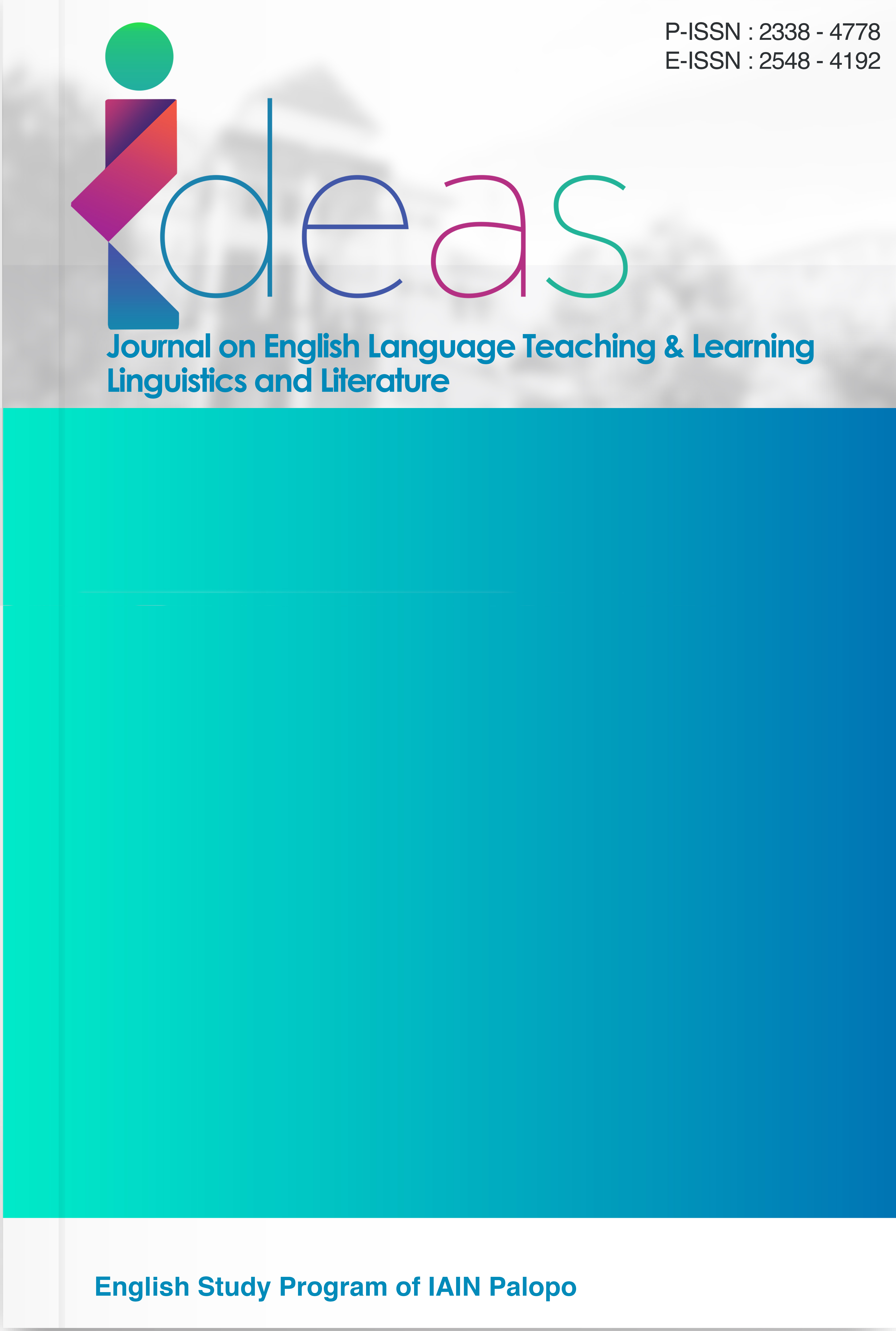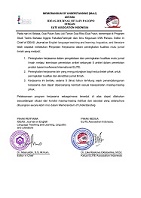Dynamic Student’s Public Speaking Through Digital Application
DOI:
https://doi.org/10.24256/ideas.v13i2.7315Keywords:
Book Creator, Digital Application, Public SpeakingAbstract
This study explores the perceptions of third-semester students in the English Education Study Program at Universitas Muhammadiyah Tangerang regarding the use of the Book Creator application as a digital tool to support the development public speaking especially in application of public speaking elements. Using a descriptive qualitative method, data was collected through interviews with 32 students and 1 lecturer teaching the public speaking course, as well as analysis of student video project documents. The results indicate that 29 out of 32 students experienced improvement in at least one element of public speaking, including facial expressions, eye contact, hand gestures, body movements, and voice. Multimedia features such as video, audio, text, and image insertion encouraged repeated practice, self-evaluation, and increased self-confidence. Students also developed greater creativity and clarity in crafting their messages. These results support the implementation of a reflective and student-centered learning approach in a digital environment. However, this study is limited by its small sample size and single institutional context. Practical implications suggest that educators can integrate Book Creator to develop public speaking skills in a flexible and engaging manner, tailored to the needs and learning styles of learners.
References
Aminin, Z., Fauzia, N., & Rosyid, A. (2022). Public Speaking: Several Essential Challenges. December, 22–23.
Arjulayana, A., Gunawan, Y. I., & Tri Pujiati. (2024). Penyusunan Bahan Ajar Online dalam Kontribusi Merdeka Belajar bagi Guru MTs di Tangerang. Keris: Journal of Community Engagement, 4(1), 31–43. https://doi.org/10.55352/keris.v4i1.832
Arjulayana, A., & Pujiati, T. (2025). Dynamic EFL learning application through assemblr EDU for s tudent ’ s creative writing. Englisia: Journal of Language, Education, and Humanities, 12(2), 90–100.
Arjulayana, Rafli, Z., & Dewanti, R. (2021). A Multiliteracy-Based Public Speaking Module (Arjulayana, Z. Rafl, & R. Dewiantii (eds.)). Yayasan Barcode.
Braun, V., & Clarke, V. (2006). Thematic analysis revised. Journal of Chemical Information and Modeling, 53(9), 1689–1699.
Cheng, Y., Boyraz, M., Taylor, J. L., & Gilbert, R. (2023). Investigating College Students’ and Instructors’ Perspectives on Adopting Technologies for Public Speaking Skills Development in a Hispanic Serving University. International Journal of Education and Development Using Information and Communication Technology (IJEDICT), 19(1), 80–101.
Creswell, J. W., & Guetterman Timothy C. (2017). Educational Research (Sixth Edit, Vol. 4, Issue 1). Copyright.
Deswarni, D., Sepyanda, M., Efriza, D., & Zaim, M. (2023). Media Trends and Students ’ Perceptions of Using Book Creator in English Learning : Audiovisual Media in Education. 03(01), 270–283.
El Mortaji, L. (2018). University Students’ Perceptions of Videotaping as a Teaching Tool in a Public Speaking Course. European Scientific Journal, ESJ, 14(8), 102. https://doi.org/10.19044/esj.2018.v14n8p102
Eubanks, J.-F., Yeh, H.-T., & Tseng, H. (2018). Learning Chinese through a twenty-first century writing workshop with the integration of mobile technology in a language immersion elementary school. Computer Assisted Language Learning, 31(4). https://doi.org/https://doi.org/10.1080/09588221.2017.1399911
Fitria, T. N. (2024). Using “Book Creator” Application in Making e-Modules as Teaching Material for English TOEFL Courses. International Journal of Computer and Information System (IJCIS), 05(02). https://doi.org/https://ijcis.net/index.php/ijcis/index
Furwana, D., Muin, F. R., Zainuddin, A. A., & Mulyani, A. G. (2024). Unlocking the Potential: Exploring the Impact of Online Assessment in English Language Teaching. IDEAS: Journal on English Language Teaching and Learning, Linguistics and Literature, 12(1), 653-662.
Hendra, Afriyadi, H., Tanwir, Noor Hayati, Supardi, Laila, S. N., Prakasa, Y. F., Hasibuan, R. P. A., & Asyhar, A. D. A. (2023). Media Pembelajaran Berbasis Digital (Teori & Praktik). In PT. Sonpedia Publishing Indonesia (Issue 1). https://repository.uinmataram.ac.id/2683/1/Media pembelajaran berbasis digital.pdf
Husnaini, H. (2022). Development of Self Esteem-Oriented Micro Teaching Materials for IAIN Palopo English Education Students. IDEAS: Journal on English Language Teaching and Learning, Linguistics and Literature, 10(1), 538-560.
Jade, B., Dina, R., & Donna, K. (2021). Handbook of Research on Empowering Early Childhood. IGI Global.
Karnedi Karnedi, & Silvia Utami. (2024). USE OF DIGITAL STORYTELLING(DST)IN PUBLIC SPEAKINGSUBJECT:AN INNOVATION. Jurnal Pendidikan Bahasa Inggris Proficiency, 15(1), 37–48. https://doi.org/https://doi.org/10.32503/proficiency.v6i1.4776
Mamom, J. (2020). Digital Technology: Innovation for Malnutrition Prevention among Bedridden Elderly Patients Receiving Home-Based Palliative Care. Journal of Hunan University Natural Sciences, 47(10). http://www.jonuns.com/index.php/journal/article/view/461%0Ahttps://www.jonuns.com/index.php/journal/article/viewFile/461/458
Paradewari, D. S. (2017). Investigating Students’ Self-Efficacy of Public Speaking. International Journal of Education and Research, 5(10), 97–108. https://doi.org/https://doi.org/ISSN: 2411-5681
Rengganawati, H. (2024). Kecemasan Dalam Berbicara Di Depan Umum Pada Kalangan Mahasiswa Berusia 17-22 Tahun. Indonesian Journal of Digital Public Relations (IJDPR), 2(2), 60. https://doi.org/10.25124/ijdpr.v2i2.6953
Risdayani, N., Limbong, E., & Sunggingwati, D. (2024). EFL Pre-Service Teachers’ Experiences in Speaking through a Digital Storytelling Project. Jambura Journal of English Teaching and Literature, 5(1), 25–38. https://doi.org/10.37905/jetl.v5i1.24667
Salim, S. S., & Joy, I. E. (2018). Public Speaking Skills. Training Manual on Theeranaipunya - Equipping Fisherwomen Youth for Future, 1, 387.
Schmidt, R., Emmerich, K., & Schmidt, B. (2015). Entertainment Computing - ICEC 2015. 9353(November), 533–538. https://doi.org/10.1007/978-3-319-24589-8
Silviyanti, T. M., Achmad, D., Shaheema, F., & Inayah, N. (2022). The Magic of Storytelling: Does Storytelling through Videos Improve EFL Students’ Oral Performance? Studies in English Language and Education, 9(2), 521–528. https://doi.org/10.24815/siele.v9i2.23259
Zheng, B., Lin, C.-H., & Kwon, J. B. (2020). The impact of learner-, instructor-, and course-level factors on online learning. Computers & Education Science Direct, 150. https://doi.org/https://doi.org/10.1016/j.compedu.2020.103851
Zulhermindra, Z., & Hadiarni, H. (2020). Improving Students’ Public Speaking Skills Through the Use of Videotaped Feedback. Ta’dib, 23(1), 75. https://doi.org/10.31958/jt.v23i1.2008
Downloads
Published
Issue
Section
Citation Check
License
Copyright (c) 2025 Rahmadini Windy Pramesti, Arjulayana, Moh Iqbal Firdaus

This work is licensed under a Creative Commons Attribution-ShareAlike 4.0 International License.
Authors retain copyright and grant the journal right of first publication with the work simultaneously licensed under an Attribution-ShareAlike 4.0 International (CC BY-SA 4.0) that allows others to share the work with an acknowledgement of the work's authorship and initial publication in this journal.
Authors are able to enter into separate, additional contractual arrangements for the non-exclusive distribution of the journal's published version of the work (e.g., post it to an institutional repository or publish it in a book), with an acknowledgement of its initial publication in this journal.
Authors are permitted and encouraged to post their work online (e.g., in institutional repositories or on their website) prior to and during the submission process, as it can lead to productive exchanges, as well as earlier and greater citation of published work (See the Effect of Open Access)




